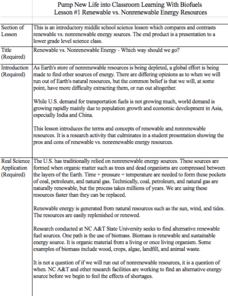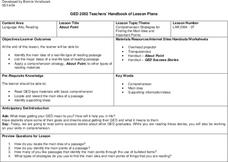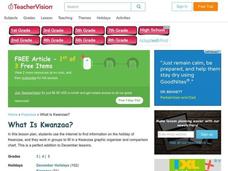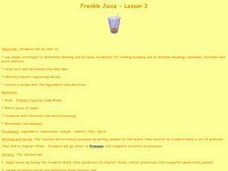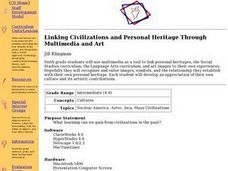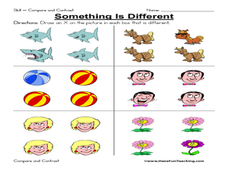Equality and Human Rights Commission
Influencing Attitudes
Does propaganda—like that used during the first World War—exist today? The 11th lesson in a series of 12 highlights the role of media when it comes to influencing attitudes. Scholars learn about sensational headlines, misrepresentation...
Kenan Fellows
Renewable vs. Nonrenewable Energy Resources
Is one type of energy inherently good or bad? Young scientists explore energy resources in a week-long unit. After extensive research, groups create powerful position statements and presentations supporting their energy resource of choice.
Bowland
Alien Invasion
Win the war of the worlds! Scholars solve a variety of problems related to an alien invasion. They determine where spaceships have landed on a coordinate map, devise a plan to avoid the aliens, observe the aliens, and break a code to...
PBS
How to Teach Your Students about Fake News
What media literacy skills do people need to evaluate a news source? Scholars listen to and discuss an NPR story about how fake headlines often dupe young people and adults alike. Next, they study news stories, using a fact-checking...
PBS
What Makes A Good Video Report?
As part of a media literacy unit, class members establish criteria for good video reporting, and practice giving both positive (warm) and constructive (cool) criticism.
Cornell University
Building Spectroscope
Given specific materials, scholars follow a set of instructions to build and calibrate their very own spectroscopes. After construction, they test the scope for accuracy and make modifications where necessary.
Curated OER
The Ideal Employee
Students participate in role playing activities that help them practice successful job interview skills. They take part in mock interviews with employers from the surrounding area. This provides excellent feedback for students about their m
Curated OER
What Is Kwanzaa?
Students use vocabulary related to Kwanzaa. They identify main ideas and details related to the celebration of Kwanzaa and summarize information about Kwanzaa. They make picture books appropriate for first and second graders.
Curated OER
Animals in Inspiration
Students research information on a specific animal. In this animal lesson, students use books to find information about an animals diet, habitat, appearance, and any other interesting facts. Students will use this information to create a...
Curated OER
Listening Comprehension - Newspaper Articles
Students demonstrate understanding of main points of the Deseret News article, and identify the verb(s) of each phrase to aid in listening comprehension.
Curated OER
Thank you Ma'm Langston Hughes-Devoloping the concept of Theme
Students complete various activities linked to several stories and movies, to reinforce the concept of theme in a story.
Curated OER
Roles of the President
Students read a document which explains the roles and responsibilities of the President of the United States. In groups, they tour the George Bush Presidential Museum and participate in a Presidential scavenger hunt. Once back in the...
Curated OER
Freckle Juice - Lesson 3
Students complete activities with the book Freckle Juice by Judy Blume. In this literature lesson, students read Chapter two and find the definitions for new vocabulary words. They also complete an online activity for...
Curated OER
Lyndon B. Johnson's Presidency
Students interpret historical evidence presented in primary and secondary resources. For this presidential history lesson, students research the accomplishments of Lyndon B. Johnson. Students create wanted...
Curated OER
Be A Perfect Person in Just Three Days- Lesson 5
Students read a chapter in a book. In this reading and vocabulary lesson, students predict what will happen in chapter 5 of Be A Perfect Person in Just Three Days, define new vocabulary words, read and discuss chapter 5, find...
Curated OER
Muggie Maggie - Lesson 5
Pupils complete activities with the book Muggie Maggie by Beverly Cleary. In this literature lesson, students discuss new vocabulary words and definitions for Ch. 5. They read Ch. 5 and find synonyms and antonyms for their vocabulary...
Curated OER
Exploring Equations and Y-Intercept
Students graph linear equations using intercepts, find y-intercept, find x-intercepts and graph linear equations that use horizontal and vertical lines.
Curated OER
Language Arts: Paraphrasing Research Material
Students visit the school media center to research their favorite historical figures. Following a discussion of paraphrasing, they find information in library materials about their figure. Once students compile their information, they...
Curated OER
Freckle Juice- Lesson 3
Young scholars read and respond to a chapter in a book. In this vocabulary and reading comprehension instructional activity, students preview and predict chapter 3 of Freckle Juice, define new vocabulary words, read chapter 3 and...
Curated OER
Why We Study Trigonometry
Students investigate the different properties of trigonometry. In this precalculus lesson, students find the six different identities of trigonometric ratios. They relate the ratios to that of a right triangle and apply it to real life...
Curated OER
Because of Winn-Dixie
Students make connections with the book Because of Winn-Dixie through writing. In this writing lesson, students pretend to be the main character and write a letter to her mother, using very descriptive language. Students also...
Curated OER
How to Study For a Test
Students discuss test taking strategies. In this studying lesson, students look in their Test Packet to find which questions they answered incorrectly and why they got them wrong. They create a manual to prepare for a successful test.
Curated OER
Linking Civilizations and Personal Heritage Through Multimedia and Art
Young scholars explore images, symbols, and the relationship they establish with their own personal heritage. They discuss Aztec, Inca, and Maya civilizations. Students interview their family about their own personal heritage. Additional...
Curated OER
Something is Different: Same/Different
In this different/same worksheet, student draw an X on the picture in a box that is different from the others, 6 sets total. A reference web site is given for additional activities.

